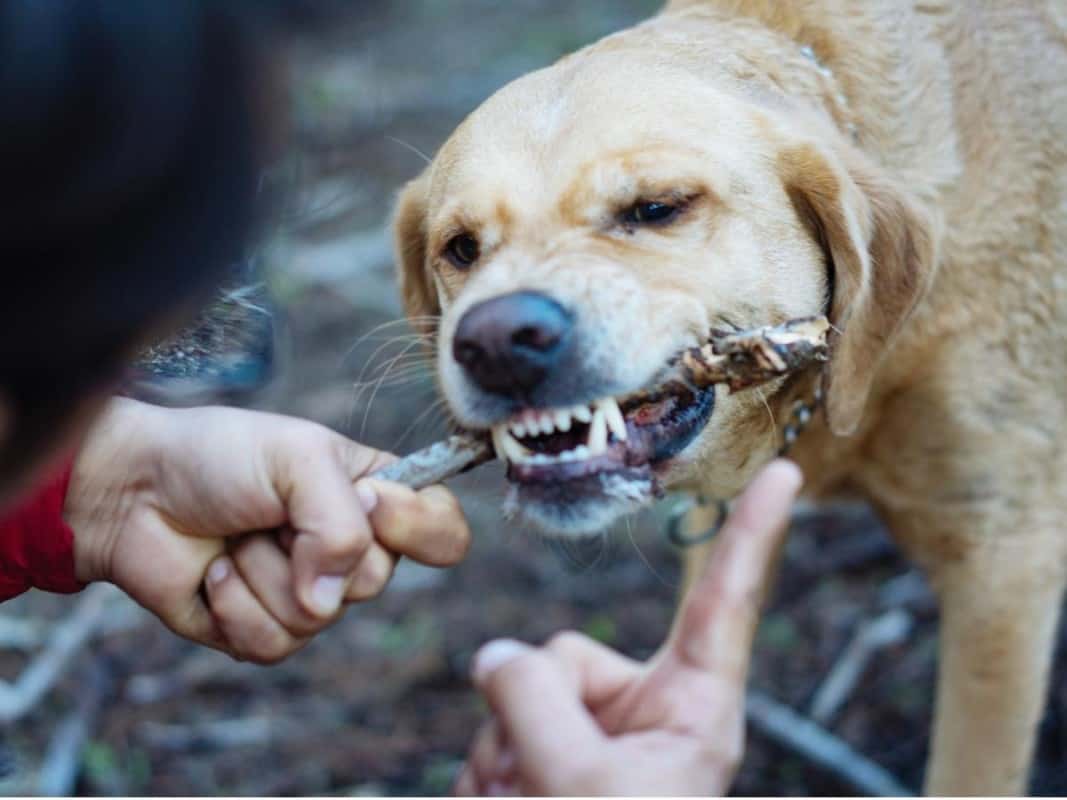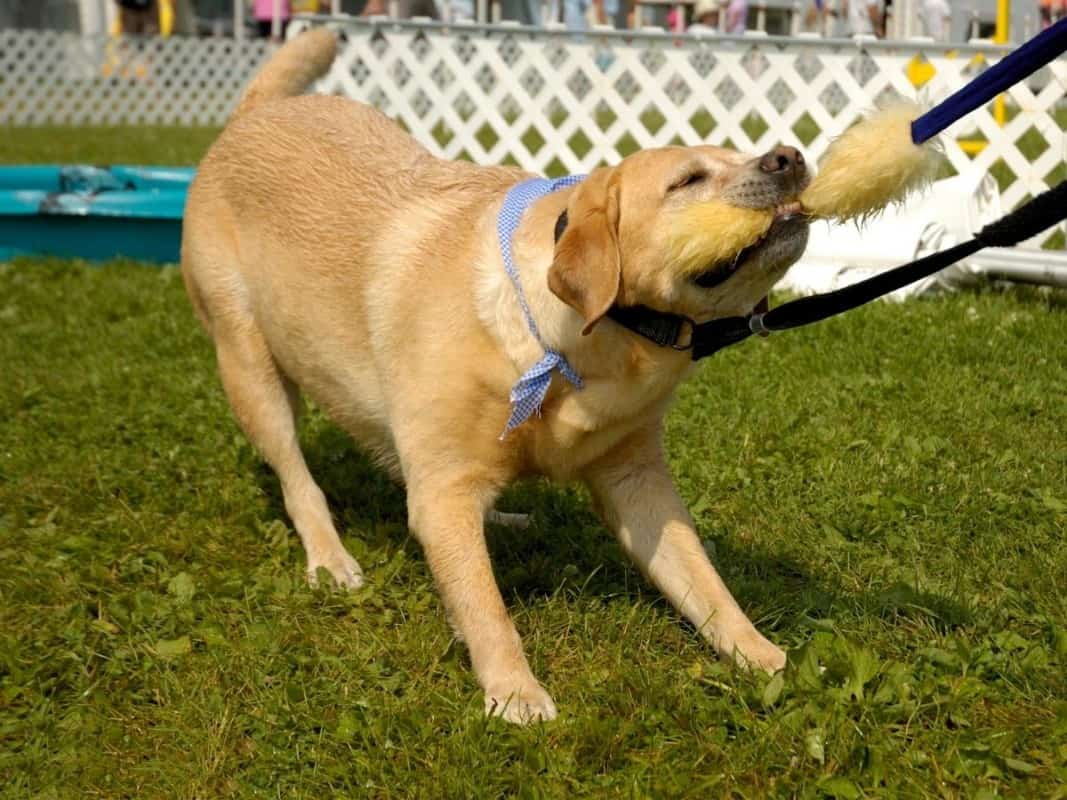Humans attach a negative connotation to stubbornness in dogs, just like we do with each other. And like humans, stubborn dogs are even more determined to stand their ground when their owners provide obedience cues. Luckily, a stubborn Labrador can be made to obey with a few simple tricks.
Here are five ways to quickly train a stubborn Labrador.
- Use reward-based training.
- Train your Lab to focus on you and tune out distractions.
- Use distractions and excitement as rewards.
- Teach your Lab that you are in charge.
- Enroll your Lab in obedience classes.
Stubbornness in dogs can be complicated as the origin is often unknown. And knowing whether your Lab is stubborn, what caused it, and how to counter the stubbornness is crucial for a healthier pet-human relationship.

So before we explore how to train your dog, let’s find out if your Labrador is stubborn.
Can Labradors Be Stubborn?
Labradors can be stubborn if we see stubbornness as a trait where a dog ignores a command it’s been trained to obey. While it isn’t a common trait in Labs, it appears from time to time. In most cases, Labradors are natural pleasers and tend towards obedience rather than stubbornness.
Here are some examples of dog behavior that would classify as stubbornness:
- Your Lab ignores your voice and doesn’t obey simple commands like “SIT.” Instead, he stares into space as though he hasn’t heard you.
- Your Lab makes you repeat commands several times before they heed with a resigned attitude.
- Your Lab constantly pulls on the leash during walks even though he’s been trained in leash walking.
A professional dog trainer will tell you that Labradors, as well as other dogs, aren’t ‘stubborn.’ What dog owners assume to be stubbornness is behavior that reflects gaps in a dog’s training. However, sometimes, a dog can seem stubborn due to health or emotional issues.
Why Are Labradors Stubborn?
Labradors can be stubborn for various reasons, and you can see why in the list below.
- Your Labrador is distracted.
- Your Labrador is excited.
- Your Labrador is spoilt.
- Your Labrador doesn’t like its treats.
- Your Labrador finds your cues confusing.
- Your Labrador is not feeling well.
- Your Labrador is stressed.
It’s more straightforward to deal with your dog if you know why he’s being stubborn in the first place. Understanding the reasons will help you greatly when training a stubborn dog.
Your Labrador Is Distracted
One of the fundamental aspects of dog training is attention. Teaching your dog to focus and tune out any distractions in its surroundings is crucial to preventing stubborn behavior.
If you find your Labrador not listening when you say “WATCH ME! or “LET’S GO!” but instead focusing on distractions, there’s a training gap, and your Labrador needs a refresher course in attention training.
Your Labrador Is Excited
Dogs get excited for various reasons, including having company over, going to dog parks, or the mere scent of grass as you take a walk.
An excited Lab can become uncontrollable and ignore your command to “STOP!” or “SIT!” because he’s unable to resist the temptation that’s in front of him.
It’s imperative to teach your dog that he can only leave for a walk when he’s calm and obeys. Otherwise, the excited behavior will persist, and your dog will continue to ignore commands and seem stubborn.

Your Labrador Is Spoilt
Most dog owners spoil their dogs without even realizing what they’re doing. While giving your dog a treat every now and then can help teach them obedience, overdoing it and allowing your Lab to have his way can make him quite unmanageable.
A spoiled Lab will drag you with the leash to where he wants to go and ignore attempts or commands to stop him. If you’ve allowed this to happen consistently, your Labrador can eventually become stubborn.
Your Labrador Doesn’t Like Its Treats
In training, rewards act as reinforcers by helping to maintain or increase the frequency of desirable behavior. In simpler terms, dogs respond to and eventually learn behavior that they are rewarded for.
If your Labrador doesn’t enjoy your treats, he won’t be inclined to exhibit the behavior you’re asking of him. As a result, your dog will not respond to commands, and he won’t learn the behavior you’re trying to enforce in the long run.
A study exploring a dog’s preferences for food rewards found that dogs generally prefer varied rewards and can gradually stop responding to a cue if they’re always given the same treat as a reward.
Your Labrador may appear stubborn when he doesn’t respond to a cue even though you’re offering him a treat as a reward. However, the real issue is that your dog doesn’t find the available treat good enough and may respond better with a different option.
Your Labrador Finds Your Cues Confusing
A basic rule in using cues while training your dog is to state commands one at a time and stay consistent with them. So if you tell your dog to “SIT” three times before rewarding him, and the next time you ask him to sit five times, your Lab will think you’re giving a different command and get confused.
Additionally, your dog will likely be perplexed if you use a word cue with gestures your Lab is unfamiliar with.
In some cases, different family members use different cues to communicate the same command to your Labrador. The varied signals and hand gestures can leave your dog a little disoriented about what’s expected of him.
A confused Lab won’t know what to do and may continue what he was doing earlier, like lying on the carpet when you’re asking him to move to his “CRATE.”
Your Lab Is Not Feeling Well
A sick dog doesn’t find any activity exciting as he may be overcome by the pain or discomfort caused by the illness.
If that’s the case, your dog will likely ignore the commands he typically obeys. As such, if your Lab isn’t usually stubborn but suddenly seems indifferent to your commands, contact a vet to rule out any possible health conditions.
Your Labrador Is Stressed
Like humans, dogs can get overwhelmed by certain situations and become stressed. One of the signs of stress in dogs is displacement or avoidance behavior. In other words, your dog tends to focus on something else to distract itself from an unpleasant situation.
Your Lab may start sniffing around or simply turn away when you ask him to “COME” or “SIT.” While you may interpret this as stubbornness, your disobedient Labrador merely communicates that the situation is too much for him to handle.
It’s best to mention here that dogs mirror the stress levels of their owners. So if your Lab is being avoidant and stubborn due to stress, the original culprit could be you!
If you find any of these reasons playing a role in your dog’s stubbornness, the next step is to figure out how to train a stubborn Labrador.
How To Train a Stubborn Labrador
From the causes of dog stubbornness discussed above, it’s easy to tell that you cannot resolve every stubborn behavior with training. If your dog ignores your commands because he’s sick or stressed out, you need to see a vet.
And if your Lab is being disobedient because he’s confused, you need to be more consistent with your commands.
However, if your Labrador is being outright disobedient, has no sign of sickness, and your Labrador training commands are clear, then training is needed to correct the stubborn behavior.
Watch How To Train a Stubborn Dog In This Video…
Let’s now dive into 5 ways how to train a stubborn Labrador.
1. Use Reward-Based Training
The most likely reason your Labrador is stubborn is that he finds no satisfaction (reward) in responding to your commands. As such, you should consider training or retraining your dog to be obedient using rewards as positive reinforcement.
Positive-reinforcement training is built on the philosophy that rewarded behavior is repeated and eventually performed without the need for reward. For a dog, rewarded behavior is associated with a positive outcome and will soon become its natural response.
To train your stubborn Lab using reward-based training, follow these four principles:
- Find out what your Lab considers as a reward. This could be food, toys, or attention by stroking or praising.
- Reward your Lab every time he responds to a cue. Rewarding should be done immediately when the desired behavior happens so your dog can associate the behavior to the reward. Also, vary your rewards, so your Lab isn’t always expecting a treat when you intend to praise him instead.
- Make positive reinforcement a lifestyle. This means ensuring you give your Lab some form of reward every time you notice obedience and good behavior. By doing so, you make obedience and portraying desired behavior the norm.
- Avoid unintended rewards. Sometimes you may unintentionally reward your Lab for undesired behavior. For example, if you ask your Lab to come to you and he continues to lie on the couch while you stare at him insistently, your dog may find that attention rewarding. In this case, you’re rewarding stubbornness.
2. Train Your Lab To Focus on You and Tune Out Distractions
The trick to building attention is to begin training in the calm environment of your home and gradually introduce distractions until your dog can focus with the distractions.
For example, if you’re teaching a stubborn Labrador the “WATCH ME” command, place his favorite toy a few feet away while asking him to watch you. Once your Lab can focus on you while watching the toy from afar, move the toy nearer and ask your Lab to watch you. Eventually, move the toy right next to him and ensure he can still focus on you.
If your Labrador can concentrate on you while the toy is next to them, you’re building obedience and curbing stubbornness.

3. Use Distractions and Excitement as Rewards
If your Labrador gets stubborn when there are distractions or excitement, you can use these by turning them into rewards.
For example, if smelling every blade of grass during walks gets your Lab excited, and he begins to pull on the leash, you can rein it in and teach him that he must heed your calls to enjoy the reward of smelling the grass.
Here’s how you can use your Lab’s excitement for the grass to curb his stubbornness:
- Take your Labrador for a walk and take a clicker with you.
- Wait until your dog tries to smell the grass and begins pulling on the leash.
- Hold the leash and wait till your dog stops pulling and comes back to you.
- Press the clicker when your Lab returns, then send him to smell the grass. You could say, “Go smell the grass,” and stick to that as a cue.
- Repeat the procedure each time your Lab pulls on the leash to smell grass until your dog learns that he only gets the reward when he is obedient.
4. Teach Your Lab That You Are in Charge
Letting your Labrador always have his way is the perfect setting to build stubbornness and disobedience. Instead, you should remind your dog constantly that you are in charge.
Teaching your Lab that you are in charge has nothing to do with the alpha-training methods that use dominance techniques. On the contrary, it’s about asserting and establishing control without using force.
Here are a few ways to establish control over a naughty Labrador and let the dog know you are in charge:
- Step in front of your Lab so he gives way and lets you go through the door first.
- Avoid playing with your Lab every time he wants to play. Instead, focus on playing when you want to.
- Vary your vocal tone to communicate satisfaction and displeasure. For example, use a firm, low-pitch tone to give forbidding commands and a lighthearted, high-pitch tone for reward cues that affirm desired behavior.
- Don’t let your Labrador take the lead during walks, because if you are dragged along on the leash you give your dog the idea that he’s in control. And that’s a surefire way to make him stubborn.
- Exercise patience and avoid showing frustration or getting emotional. Dogs have a sort of sixth sense for unstable human behavior, which could lead to disobedience as they get confused about commands you give in an aggressive tone.
Do you want to learn exactly how to discipline your dog? Check out this article, How to Discipline a Labrador.
5. Enroll Your Lab in Obedience Classes
Enrolling your Lab in obedience classes is a last-resort option if you can’t get your disobedient Labrador to give up his stubborn behavior. Alternatively, you can hire a private dog trainer to teach your naughty Labrador at home. If you aren’t sure where to find a reliable trainer, talk to your local vet for references.
Key Takeaways
Now that you’ve got a glimpse of how to deal with a stubborn Lab, let’s summarize what we learned in the article.
- To correct a Labrador’s stubborn behavior, train your dog using positive reinforcement and help him tune out distractions and focus on you.
- Labradors can be stubborn if distracted, excited, or spoiled. If none of these reasons are causing your Lab’s stubbornness, your dog could have health or emotional issues.
- If your efforts to eliminate your Lab’s stubbornness are futile, hire a professional dog trainer or enroll your Lab in obedience classes.





